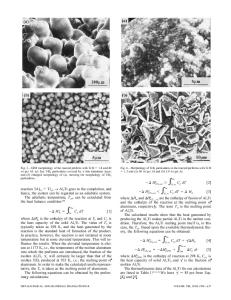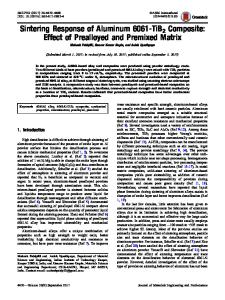Tribological properties of aluminum alloy matrix TiB 2 composite prepared by in situ processing
- PDF / 1,469,429 Bytes
- 12 Pages / 612 x 792 pts (letter) Page_size
- 55 Downloads / 357 Views
I.
INTRODUCTION
The incorporation of a hard phase in a soft matrix to achieve excellent tribological properties is well known. Babbit metal and 52100 steel consist of hard SbSn intermetallic and carbide particles, respectively, which stand in relief and provide wear resistance.[1] The ductile softer matrix serves to distribute the load more evenly and provides toughness and fatigue resistance. Aluminum-silicon alloys are an example of a two-phase material in use because of wear resistance. Hypereutectic Al-Si alloys, such as the A390, are currently used in engine blocks.[2] An electrochemical surface treatment is employed to etch away the aluminum matrix so that the eutectic and the primary silicon particles provide the bearing surface. The recessed matrix serves as a reservoir for the lubricant, which is carried into the contact region by the relative motion of the counteracting surfaces.[1] Due to the low weight, high strength and stiffness, and enhanced wear resistance of particulatereinforced aluminum-based metal matrix composites (MMCs), the automotive industry has identified a number of applications for these materials.[3] The weight reduction achieved by the use of these MMCs results in superior fuel economy and higher engine performance. The interfacial region between the matrix and the reinforcing phase serves as a coupling to transmit the load beC.A. CARACOSTAS, formerly Graduate Student, Department of Materials Science and Engineering, Northwestern University, is Senior Research Engineer, Abrasives Division, Norton Co., Worcester, MA 01615. W.A. CHIOU, Research Associate Professor, and M.E. FINE, Walter P. Murphy Professor, are with the Department of Materials Science and Engineering, and H.S. CHENG, Walter P. Murphy Professor, is with the Dept. of Mechanical Engineering, Northwestern University, Evanston, IL 60208. Manuscript submitted January 25, 1996. METALLURGICAL AND MATERIALS TRANSACTIONS A
tween the constituent phases of the MMC. The effect of the type of the reinforcement on the wear properties of aluminum-based MMCs was reported by Bhansali and Mehrabian.[4] For the same aluminum alloy matrix (2014 and 2024-Al), Al2O3-reinforced MMCs exhibited higher wear resistance than SiC-reinforced MMCs. This behavior was attributed to the brittle interface that SiC forms with the aluminum alloy matrix. It was pointed out by Pan[5] that low fracture resistant interfaces, which were found to increase toughness in ceramic matrix composites[6] by promoting crack deflection, are not beneficial to wear. Strong bonding between the constituents of an MMC results in reduced particle pullout, which leads to less third-body wear during the wear process. Low energy particle matrix interfaces as well as ductile bonds across the interfaces are desirable.[1,7] The constituent phases of MMCs produced by mechanical mixing are not necessarily in thermodynamic equilibrium. In the extensively studied Al/SiC system. SiC and Al react to form Si and Al4C3, since the free energy of formation of the latter per mole of C is close t
Data Loading...











